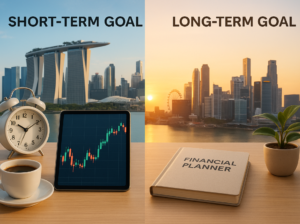Introduction
Inflation and interest rates are pivotal factors in shaping the world of investments, influencing everything from stocks to real estate. For savvy investors, understanding their relationship with various investment avenues is vital for effective financial planning.
This blog will delve into the complex interplay between inflation and interest rates while offering valuable strategies to navigate these economic tides. Join us as we explore how you can stay ahead of these market forces and maximise your returns on investment.
Understanding The Relationship Between Inflation, Interest Rates & Investments
Inflation and interest rates are important economic factors that can have a significant impact on investment returns, with inflation driving up the cost of goods and services and interest rates affecting borrowing costs for businesses.
Defining Inflation And Interest Rates
Inflation can be simply defined as the rate at which the general price level of goods and services in an economy increases over a period of time. It reflects the erosion of purchasing power, meaning that each unit of currency buys fewer items than it did before. Inflation is typically measured by the Consumer Price Index (CPI), which tracks changes in the cost of living through periodic sampling of various essential products and services.
On the other hand, interest rates represent the cost of borrowing or lending money over time. They are set by central banks, such as the Bank of England or Federal Reserve, to help control inflation and maintain economic stability. When inflation rises, central banks often respond by increasing interest rates to dampen spending and shrink credit availability. Conversely, during times when inflation falls or remains low, interest rates may be lowered to stimulate borrowing and spending within an economy.
To illustrate these concepts in action: if a trader invests £1,000 into stocks with a projected 5% annual return but experiences 3% inflation during that same year – their real return on investment would decrease to only 2%. Therefore, understanding how both inflation and interest rates function is crucial for investors to make informed decisions that maximise returns whilst mitigating risks inherent within financial markets.
The Impact Of Inflation And Interest Rates On Investments
The impact of inflation and interest rates on investments is significant, as these economic factors influence the performance of various asset classes, including stocks. When inflation rises, it erodes your purchasing power, meaning that with the same amount of money, you can purchase fewer goods and services over time. This can lead to decreased consumer spending and slower economic growth that may hinder corporate profitability. Consequently, stock prices could experience a decline under such conditions.
However, central banks often step in to manage inflationary pressures through changes in interest rates. For instance, when they raise interest rates in response to high inflation levels or a buoyant economy at risk of overheating, borrowing costs for businesses increase accordingly. This leads companies to curtail their expansion plans or cut back on spending which might lead to stunted growth or even contraction resulting in reduced demand for stocks among investors as share prices drop due to lower earnings expectations.
In contrast, falling interest rates and low or stable inflation often stimulate business investment and consumer spending by reducing the cost of borrowing funds promoting economic growth; thus positively affecting the stock market’s performance. To illustrate this point better: consider Company A during an environment where low-interest rates prevail making access to capital cheaper enabling them make significant investments leading increased sales thereby generating higher revenues pushing up its share price attracting more investors into buying their stocks hence driving the overall market up.
Overall understanding how both inflation and Interest rate environments affect different sectors within your investment portfolio helps better prepare for shifting dynamics allowing you planstrategies aimed at maximising returns while managing risks associated with both rising and falling economies ensuring your financial goals remain on track despite any potential headwinds encountered along way.
The Correlation Between Inflation, Interest Rates And Investments
Inflation and interest rates can have a significant impact on investments. In general, high inflation leads to high-interest rates as the central banks aim to reduce the money supply, while low inflation leads to lower interest rates to boost borrowing and spending. This correlation has an impact on the stock market, bond prices, real estate values, and other types of investments.
For example, in times of rising inflation rates, stock prices may initially rise as companies raise prices for their goods and services. However, over time rising inflation can lead to higher costs for raw materials or wages that can squeeze profit margins leading investors away from stocks towards fixed-income securities like bonds or Treasury bills with corresponding yields. The relationship between inflation and different asset classes is complex but understanding these relationships will help investors make informed decisions about how best to position their portfolios during periods of rising or falling rates of inflation.
In summary, knowing how investment performance is impacted by changes in both interest rates and levels of inflation is crucial when formulating an investment strategy. Investing in assets that provide protection against a possible increase in future inflation; such as gold or commodities have often been touted as good avenues for those seeking this protection during uncertain economic times characterized by rampant price increases across various market sectors overly dependent on natural resources like energy generation (oil), mining activities (coal) among several others significantly affected by unexpected weather patterns which could trigger huge fluctuations either negatively impacting business operations slowing output capacity impacting profits which consequently affects capital allocations available for growth initiatives!
The Effect Of Inflation & Interest Rates On Investments
Inflation and interest rates can have varied effects on different types of investments, such as equity, bonds, real estate, and savings.
The Impact On Equity Investments
Equity investments, such as stocks and shares, are particularly sensitive to inflation and interest rates. When inflation is high, it can have a negative impact on company profits which ultimately affects stock prices. Additionally, rising interest rates can increase the cost of borrowing for companies which may result in lower profits or earnings per share.
However, not all equity investments perform equally during periods of inflation and rising interest rates. Historically, some sectors fare better than others during these times. For example, defensive sectors such as healthcare tend to outperform cyclical sectors like consumer discretionary when inflation is high due to greater demand for essential goods and services that these companies provide.
It’s important to note that while equity investments can be impacted by macroeconomic factors like inflation and interest rates in the short-term; long-term trends suggest that equities generally provide higher returns than fixed-income assets over time. Therefore, investors who hold a diversified portfolio of equities with exposure to both defensive and growth-oriented sector funds could potentially offset the risks associated with fluctuations in the market caused by changes in inflation or interest rate environment.
The Effect On Bond Investments
Bonds are a popular investment choice for investors looking for stable income streams. However, inflation and rising interest rates can cause significant challenges in this regard. Inflation erodes the purchasing power of future cash flows from bonds, making it a detrimental factor for fixed-rate investments like bonds. As such, investors will see their real returns diminish as the rate of inflation rises.
Additionally, when interest rates increase, bond prices decrease. Conversely, when interest rates decrease, bond prices go up. This inverse relationship is an essential principle to understand when investing in bonds. Thus, rising interest rates can cause immediate pain for fixed-income investors with falling bond prices and vice versa.
To mitigate these risks associated with investing in bonds during volatile times like increased inflation or rising interest rates environment, investment portfolios should be reviewed regularly by financial professionals who take into account current market conditions and apply strategies accordingly to ensure maximum return on investments while minimizing risk factors effectively.
The Impact On Real Estate Investments
Rising inflation and interest rates can have a significant impact on real estate investments. As interest rates increase, the cost of borrowing money to purchase properties also rises, making it more expensive for investors to invest in real estate. However, if inflation is rising due to economic growth, this could also lead to higher demand for property as individuals seek housing and businesses expand.
Real estate returns are more directly sensitive to economic growth than inflation. When the economy grows, properties tend to appreciate in value due to increasing demand which leads to price appreciation. Additionally, landlords also have the ability to re-price rents upwards during periods of high inflation as the purchasing power of money declines over time. Furthermore, historical data shows that real estate has provided a strong hedge against inflation compared with other asset classes like stocks or bonds. Therefore, carefully investing in real estate can be an effective way for investors seeking protection from high levels of inflation while earning steady rental income streams.
The Effect On Cash And Savings
When inflation is high, it can adversely affect the purchasing power of cash and savings. This means that it may be difficult to maintain the real value of your money over time due to rising prices for goods and services. For example, if you have £10,000 in a savings account earning 1% interest rate while inflation is running at 3%, then the actual value or buying power of your money would decline by 2% annually.
A rise in interest rates may help savers maintain their real returns on cash deposits as banks offer higher returns to attract more capital. However, this effect may not last long if inflation continues to outpace interest rates since higher rates also mean borrowers will pay more for loans which can slow down economic growth leading to reduced investment returns across various assets classes including stocks and bonds. Therefore, investors must keep an eye on both inflation and interest rates when managing their investment portfolios.
Strategies To Manage Investments In An Inflationary Environment
To combat the negative effects of inflation on investments, there are several strategies investors can employ, including diversifying their portfolio, investing in inflation-protected securities, hedging against inflation, and adjusting their allocation to different asset classes. Discover which strategy is best for you by reading more about it below!
Diversifying Your Investment Portfolio
One of the most effective strategies to manage investments in an inflationary environment is diversifying your portfolio. When you invest in a range of assets, such as stocks, bonds, real estate and commodities, it can help protect against fluctuations in any one asset class. This means that if certain investments underperform or suffer from high inflation, others may perform well and balance out the losses.
For example, exposure to U.S. stocks and real assets may help shield money against inflation through diversification. Real estate is attributed to providing diversification and inflation protection benefits to a portfolio. Diversification also implies accessing higher-yielding financial instruments like treasury bills, notes & bonds which could provide better returns than stock markets during an inflationary period when equity market performance is weak.
Investors need access to global assets for diversification but at the same time must be careful since investing in international companies exposes investors’ portfolios’ currency risk-making investing overseas complex with different additional issues likely besides just simple allocation decisions on securities within their investment accounts according to regulatory requirements from Financial Conduct Authority (FCA).
Investing In Inflation-protected Securities
Inflation-protected securities are fixed-income investments that can help protect against the negative effects of rising inflation. These securities, such as Treasury Inflation-Protected Securities (TIPS), offer investors protection by adjusting their principal value for changes in the Consumer Price Index (CPI). As inflation rises, so does the principal value of these securities, which helps investors maintain purchasing power over time.
For traders and stock investors looking to diversify their portfolio with an inflation hedge, TIPS may be a good option. While they generally provide lower yields than traditional bonds, they can help mitigate against any losses from increasing inflation rates. Additionally, TIPS have historically performed well during periods of higher inflation and interest rates.
Investing in TIPS is a straightforward process that can typically be done through most brokerage accounts or directly from the US Treasury Department. It’s important to note that while TIPS do offer some protection against inflation risk, there remain plenty of other factors at play in investment management strategies. As always, it’s best to consult with an experienced financial professional before making any investment decisions to ensure you’re investing appropriately based on your unique circumstances and goals.
The Benefits Of Hedging Against Inflation
One of the biggest benefits of hedging against inflation is protecting the value of your investments from the effects of rising inflation. When inflation rises, it can reduce the purchasing power of your money, which makes it more difficult to maintain or grow your wealth. However, by taking steps to hedge against inflation, investors can help insulate their portfolios and potentially see continued growth even in an economic environment characterized by higher prices.
There are several effective strategies for hedging against inflation that investors may consider. For example, one popular approach is to invest in assets that have historically performed well during times of high inflationary pressure, such as real estate or commodities like gold and silver. Another strategy involves diversifying a portfolio across multiple asset classes to spread risk and take advantage of varied economic conditions. Regardless of which strategies an investor chooses, it’s important to stay vigilant about changes in market trends and adjust investment positions accordingly.
Adjusting Portfolio Allocation
As an investor, adjusting portfolio allocation is a key way to manage investments in an inflationary environment. Tactical adjustments are necessary to ensure that your investment portfolio remains balanced and financially sound. One such adjustment is increasing equity exposure and allocating resources towards market segments with higher growth potential, such as small stocks. These strategies can be effective in shielding investors against the effects of persistent inflation.
Diversification is another valuable tool for managing the impact of rising inflation and interest rates on investments. A well-diversified portfolio provides access to both higher-yielding financial instruments and global exposure – exactly what Stock Investors need when navigating volatile market conditions. This approach helps to balance risks while offering attractive returns across different asset classes, thereby reducing overall investment risk through spreading capital across various opportunities carefully.
In conclusion, adjusting your investment strategy during periods of high inflation requires careful attention to detail whilst keeping a long-term view focused on steady gains from well-positioned assets like equities or real estate. Disciplined management supported by tactical adjustments might make all the difference between enduring economic headwinds and generational wealth creation from successful investment outcomes over time for smart Stock Investors who don’t panic at times like these!
Key Takeaways For Investors
Investing can be a great tool for growing your wealth over time, but it’s important to understand the impact that inflation and interest rates can have on your investments. Inflation eats away at the purchasing power of your money, while rising interest rates can negatively affect fixed-income assets like bonds.
To combat these challenges, investors should diversify their portfolios and consider investing in inflation-protected securities. Hedging against inflation is also beneficial, as is adjusting your portfolio allocation based on market conditions.
It’s crucial to keep updated with economic news and seek advice from financial professionals if needed. By understanding the relationship between inflation, interest rates, and investments, you’ll be better equipped to make informed decisions about managing your savings and investments in an inflationary environment.
In conclusion, smart investment strategies that take into account fluctuations in both interest rates and inflation are essential tools for investors who want to achieve long-term financial security. By following these key takeaways, you’ll be well positioned to protect yourself against economic uncertainty while building a strong investment portfolio for the future.
As an investor, it is essential to understand the relationship between inflation, interest rates and investments. Inflation reduces the purchasing power of money over time as the price of goods and services increases. Interest rates represent the cost of borrowing or return on investment, regulated by financial institutions like The Financial Conduct Authority (FCA). The impact of inflation and interest rates can significantly affect your portfolio’s value in a rising inflation environment. With this new outline, we have included strategies that investors might utilize to manage their investments better.
When investing in equities during periods of higher inflation with rising interest rates, companies’ revenue streams may be negatively impacted due to decreased demand for products and services while costs increase due to higher input prices.On the other hand, bonds offer fixed-interest payments unaffected by market fluctuations but are vulnerable when inflation rises since they provide lower returns relative to current market conditions’ prevailing rates.
Real estate provides an attractive hedge against high-inflation as property values grow alongside general price levels if rental income keeps pace with those same prices. Similarly, cash holdings fell victim over time since returns do not match up against price increases resulting from rising inflation levels.
Investors should diversify their portfolios across different asset classes such as bonds, real estate stocks or alternative assets like precious metals such as gold or silver providing protection against rising prices associated with periods of higher inflation. Additionally investing in securities specifically protected against these risks could also ensure better returns during uncertain times – providing greater security for investors looking for long-term opportunities amidst volatile markets while hedging away potential losses from uncontrollable external factors like global economic instability which has been prevalent recently especially related to COVID-19 pandemic effects on businesses worldwide.
Overall understanding how changes in both interest rate environments combined with various degrees differs whilst keeping detailed notes about how management/investment adjustment works best within individual portfolios can help them stay ahead in today’s ever-changing investment arena – downplaying any fears associated when faced head-on improving their investment strategies.
Conclusion
Inflation and interest rates have a significant impact on investment portfolios. As an investor, it’s important to stay informed about how these factors affect your investments and develop strategies to manage the risks associated with high inflation and rising interest rates.
Diversifying your portfolio, investing in inflation-protected securities, hedging against inflation, and adjusting portfolio allocation can all be effective ways to protect against potential losses. By understanding the relationship between inflation, interest rates, and investments, investors can make informed decisions that positively impact their financial planning. Remember to always seek professional investment advice or recommendations before making any investment decisions in a rising inflation environment.












